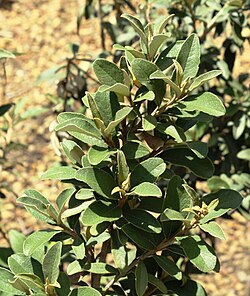| Tarchonanthus | |
|---|---|
 | |
| Tarchonanthus camphoratus | |
| Scientific classification | |
| Kingdom: | Plantae |
| Clade: | Tracheophytes |
| Clade: | Angiosperms |
| Clade: | Eudicots |
| Clade: | Asterids |
| Order: | Asterales |
| Family: | Asteraceae |
| Tribe: | Tarchonantheae |
| Genus: | Tarchonanthus L. [1] |
| Type species | |
| Tarchonanthus camphoratus [1] | |
Tarchonanthus is a genus of flowering plants in the mutisia tribe daisy family. [1] [2]
- Species [3] [4]
- Tarchonanthus camphoratus L. - Africa
- Tarchonanthus littoralis P.P.J.Herman - South Africa
- Tarchonanthus minor Less. - South Africa
- Tarchonanthus obovatus DC. - South Africa
- Tarchonanthus parvicapitulatus P.P.J.Herman - South Africa
- Tarchonanthus trilobus DC. - South Africa
- formerly included [3]